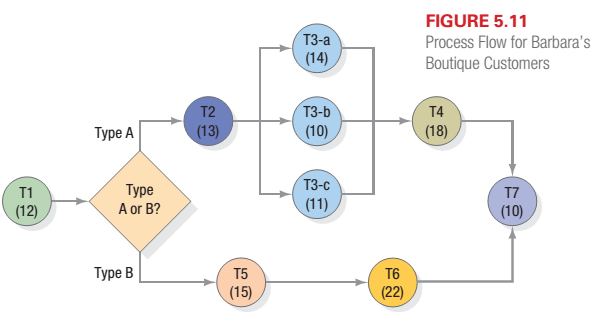
Concept explainers
Figure 5.11 details the process flow for two types of customers who enter Barbara’s Boutique shop for customized dress alterations. After Step T1, Type A customers proceed to Step T2 and then to any of the three workstations at T3, followed by Steps T4 and T7. After Step T1, Type B customers proceed to Step T5 and then Steps T6 and T7. The numbers in parentheses are the minutes it takes to process a customer.
- What is the capacity of Barbara’s shop in terms of the numbers of Type A customers who can be served in an hour? Assume no customers are waiting at Steps T1 or T7.
- If 30 percent of the customers are Type A customers and 70 percent are Type B customers, what is the average capacity of Barbara’s shop in customers per hour?
- Assuming that the arrival rate is greater than five customers per hour, when would you expect Type A customers to experience waiting lines, assuming no Type B customers in the shop? Where would the Type B customers have to wait, assuming no Type A customers?

Want to see the full answer?
Check out a sample textbook solution
Chapter 5 Solutions
Operations Management: Processes and Supply Chains (12th Edition) (What's New in Operations Management)
Additional Business Textbook Solutions
Operations Management, Binder Ready Version: An Integrated Approach
Operations and Supply Chain Management 9th edition
Loose-leaf for Operations Management (The Mcgraw-hill Series in Operations and Decision Sciences)
Principles of Operations Management: Sustainability and Supply Chain Management (10th Edition)
Business in Action (8th Edition)
Business in Action
- What type of process—project, job shop, flow shop, and continuous flow—would most likely be used to produce the following? Explain your reasoning. a) Personal computers b) Weddings c) Tax preparation d) Ice cream with many flavors e) Meals at a fast-food restaurantarrow_forwardRock View Restaurant is a new fast-food restaurant chain. The Operations Manager has dividedits normal drive-through service process into the following tasks: Tasks Description Task Time (In Seconds) Predecessors A Take Order 25 None B Receive payment 20 A C Gather drinks 35 A D Gather Food 32 A E Put food etc. In bag 25 C,D F Give food to Customer 10 B,E Currently, Rock View Restaurant has a single window with one person who takes the order,gather the food, collects the money and gives the food to the customer. This takes an average of147 seconds per customer so only 25.5 cars can be served. Rock View Restaurant wants toincrease its drive-through capacity to 60 cars per hour by forming a multi-window line.i. Using the LOT heuristic, assign the tasks to the windows to produce the desiredservice rate making sure that the precedence relationship is maintained.arrow_forwardRock View Restaurant is a new fast-food restaurant chain. The Operations Manager has dividedits normal drive-through service process into the following tasks: Tasks Description Task Time (In Seconds) Predecessors A Take Order 25 None B Receive payment 20 A C Gather drinks 35 A D Gather Food 32 A E Put food etc. In bag 25 C,D F Give food to Customer 10 B,E Currently, Rock View Restaurant has a single window with one person who takes the order,gather the food, collects the money and gives the food to the customer. This takes an average of147 seconds per customer so only 25.5 cars can be served. Rock View Restaurant wants toincrease its drive-through capacity to 60 cars per hour by forming a multi-window line.1. Calculate the efficiency of the newly design process.arrow_forward
- Rock View Restaurant is a new fast-food restaurant chain. The Operations Manager has dividedits normal drive-through service process into the following tasks: Tasks Description Task Time (In Seconds) Predecessors A Take Order 25 None B Receive payment 20 A C Gather drinks 35 A D Gather Food 32 A E Put food etc. In bag 25 C,D F Give food to Customer 10 B,E Currently, Rock View Restaurant has a single window with one person who takes the order,gather the food, collects the money and gives the food to the customer. This takes an average of147 seconds per customer so only 25.5 cars can be served. Rock View Restaurant wants toincrease its drive-through capacity to 60 cars per hour by forming a multi-window line.1. Calculate the cycle time in seconds.arrow_forwardRock View Restaurant is a new fast-food restaurant chain. The Operations Manager has dividedits normal drive-through service process into the following tasks: Tasks Description Task Time (In Seconds) Predecessors A Take Order 25 None B Receive payment 20 A C Gather drinks 35 A D Gather Food 32 A E Put food etc. In bag 25 C,D F Give food to Customer 10 B,E Currently, Rock View Restaurant has a single window with one person who takes the order,gather the food, collects the money and gives the food to the customer. This takes an average of147 seconds per customer so only 25.5 cars can be served. Rock View Restaurant wants toincrease its drive-through capacity to 60 cars per hour by forming a multi-window line.1. Draw the precedence diagram to represent the process at Rock view restaurant.arrow_forwardRock View Restaurant is a new fast-food restaurant chain. The Operations Manager has dividedits normal drive-through service process into the following tasks: Task Description Task time in seconds Predecessors A Take Order 25 none B Received Payment 20 A C Gather Drinks 35 A D Gather Food 32 A E Put food etc. in bag 25 C,D F Give food to customer 10 B,E Currently, Rock View Restaurant has a single window with one person who takes the order,gather the food, collects the money and gives the food to the customer. This takes an average of147 seconds per customer so only 25.5 cars can be served. Rock View Restaurant wants toincrease its drive-through capacity to 60 cars per hour by forming a multi-window line. Using the LOT heuristic, assign the tasks to the windows to produce the desiredservice rate making sure that the precedence relationship is maintained.Calculate the efficiency of the newly design process.arrow_forward
- Rock View Restaurant is a new fast-food restaurant chain. The Operations Manager has dividedits normal drive-through service process into the following tasks: Task Description Task time in seconds Predecessors A Take Order 25 none B Received Payment 20 A C Gather Drinks 35 A D Gather Food 32 A E Put food etc. in bag 25 C,D F Give food to customer 10 B,E Currently, Rock View Restaurant has a single window with one person who takes the order,gather the food, collects the money and gives the food to the customer. This takes an average of147 seconds per customer so only 25.5 cars can be served. Rock View Restaurant wants toincrease its drive-through capacity to 60 cars per hour by forming a multi-window line. i. Draw the precedence diagram to represent the process at Rock View Restaurant.ii. Calculate the cycle time in seconds.iii. Calculate the minimum number of windows that Rock View Restaurant will need toserve 60 cars per hour.arrow_forwardRock View Restaurant is a new fast food restaurant chain. The Operations Manager has dividedits normal drive-through service process into the following tasks:Tasks Description Task Time(InSeconds)PredecessorsA Take order 25 NoneB Receive payment 20 AC Gather drinks 35 AD Gather food 32 AE Put food etc. in bag 25 C,DF Give food to customer 10 B,E Currently, Rock View Restaurant has a single window with one person who takes the order, gather the food, collects the money and gives the food to the customer. This takes an average of 147 seconds per customer so only 25.5 cars can be served.…arrow_forwardRock View Restaurant is a new fast food restaurant chain. The Operations Manager has dividedits normal drive-through service process into the following tasks:Tasks Description Task Time(InSeconds)PredecessorsA Take order 25 NoneB Receive payment 20 AC Gather drinks 35 AD Gather food 32 AE Put food etc. in bag 25 C,DF Give food to customer 10 B,E Currently, Rock View Restaurant has a single window with one person who takes the order, gather the food, collects the money and gives the food to the customer. This takes an average of 147 seconds per customer so only 25.5 cars can be served.…arrow_forward
- Rockness Recycling refurbishes rundown business students. The process uses a moving belt, which carries each student through the five steps of the process in sequence. The five steps are as follows: STEP DESCRIPTION TIME REQUIREDPER STUDENT 1 Unpack and place on belt 1.2 minutes 2 Strip off bad habits 1.0 minutes 3 Scrub and clean mind 1.5 minutes 4 Insert modern methods 0.8 minute 5 Polish and pack 1.0 minutes One faculty member is assigned to each of these steps. Faculty members work a 40-hour week and rotate jobs each week. Mr. Rockness has been working on a contract from General Eclectic, which requires delivery of 2,000 refurbished students per week. A representative of the human resources department has just called complaining that the company hasn’t been receiving the agreed-upon number of students. A check of finished goods inventory by Mr. Rockness reveals that there is no stock left. a. Calculate the maximum output for each step. b. Which step…arrow_forwardThe Simple process has 4 steps. Step 1 & 3 has two resource units, while Step 2 and 3 only has one. The time it takes each resource unit to complete the step is also shown on the diagram. I need help understanding these and the steps that needs to be taken to answer these questions (i) What is the total capacity of the resource units in (units/hr) at each step? (ii) At which of the four steps is there a bottleneck resource pool? (iii) What is the overall process capacity? (iv) If 300 units/hr worth of raw materials flowed into the process, what would be thethroughput of the process?arrow_forwardA) Which step in this process is the bottleneck? =30 min for tan leather B) How many briefcases are processed at the bottleneck workstation per hour?=60/30=2 briefcases per hr C) What is the throughput time of the overall process?=30+15+10+10+10 Throughput = 75 minutes given the above information please answer qestions 1-3 below. If the manufacturing facility operates 8 hours per day, 250 days a year, what is the annual capacity of this manufacturing process. Assume the company decides to hire additional workers in order to duplicate the bottleneck step identified in part a so that there are 3 of these workstations instead of 1. Redraw the diagram showing the flow of the revised process. Answer parts a through d again based on the new process created in part e?arrow_forward
 Practical Management ScienceOperations ManagementISBN:9781337406659Author:WINSTON, Wayne L.Publisher:Cengage,
Practical Management ScienceOperations ManagementISBN:9781337406659Author:WINSTON, Wayne L.Publisher:Cengage, Operations ManagementOperations ManagementISBN:9781259667473Author:William J StevensonPublisher:McGraw-Hill Education
Operations ManagementOperations ManagementISBN:9781259667473Author:William J StevensonPublisher:McGraw-Hill Education Operations and Supply Chain Management (Mcgraw-hi...Operations ManagementISBN:9781259666100Author:F. Robert Jacobs, Richard B ChasePublisher:McGraw-Hill Education
Operations and Supply Chain Management (Mcgraw-hi...Operations ManagementISBN:9781259666100Author:F. Robert Jacobs, Richard B ChasePublisher:McGraw-Hill Education
 Purchasing and Supply Chain ManagementOperations ManagementISBN:9781285869681Author:Robert M. Monczka, Robert B. Handfield, Larry C. Giunipero, James L. PattersonPublisher:Cengage Learning
Purchasing and Supply Chain ManagementOperations ManagementISBN:9781285869681Author:Robert M. Monczka, Robert B. Handfield, Larry C. Giunipero, James L. PattersonPublisher:Cengage Learning Production and Operations Analysis, Seventh Editi...Operations ManagementISBN:9781478623069Author:Steven Nahmias, Tava Lennon OlsenPublisher:Waveland Press, Inc.
Production and Operations Analysis, Seventh Editi...Operations ManagementISBN:9781478623069Author:Steven Nahmias, Tava Lennon OlsenPublisher:Waveland Press, Inc.





